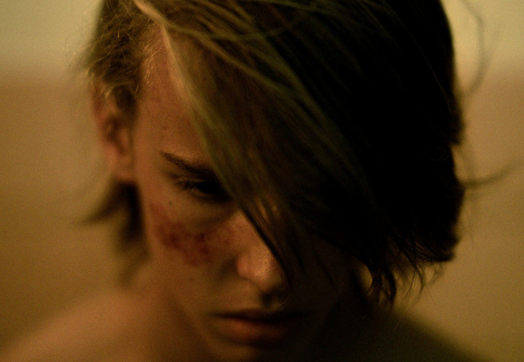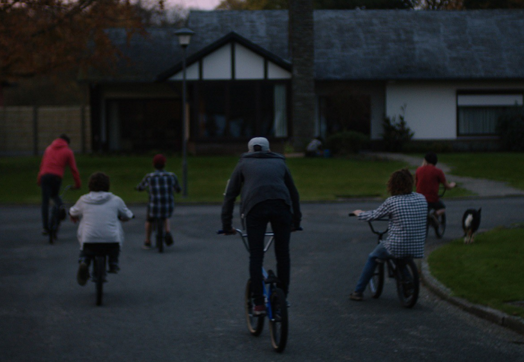Violet Bas Devos

Bas Devos' delicately surreal debut feature adopts a scrupulous lens one may liken to Béla Tarr to convey the visceral aftermath of a violent act often sought out by Gus Van Sant in critically acclaimed work like Elephant (2003) and Paranoid Park (2007) from last decade. Adhering to a pure art house aesthetic through elliptical, inexorable sensation rather than lucid story structure that's sure to divide its audience, Violet resolutely defines itself by a peculiarly minimalist screenplay that continually exerts its philosophy of "absence as presence" in terms of cinematic space. Fixated on the subtleties of human expression, more dynamic action is often pushed outside the boundaries of the narrower frame in Academy (1.33:1) aspect ratio.
The writer-director prefers personal reaction or interpretation to objective reality, permitting his film to accumulate the feeling of a slow-burning lugubrious dream, confirmed in the recurrence of superficially prosaic stationary shots that reveal an otherworldly cinematic dimension to the Flanders, Belgium, milieu. The very first flickering frame of a CCTV security monitor in the surveillance room of a shopping mall, immediately prior to a chillingly silent stabbing, institutes Devos' attraction to a removed point of view of the Kübler-Ross model that leaves fifteen-year-old Jesse (Cesar De Sutter) paralyzed in time by grief after bearing witness to the last gasps from Jonas, a member of his freestyle BMX crew.

Conventional narrative logic and psychoanalysis predict a certain course for a film following a first or second act tragedy, indicative of an independent teen tale like Jacob Aaron Estes' Mean Creek (2004); yet, Devos more clearly identifies with a free-form experimentalism, adopting the adrift and distraught mindsets of the daredevils themselves, who repeatedly run laps around solace and take to the air but never directly tackle their hanging anguish. This oblique route in effect establishes a emotionally tenuous mood that neither promises forbearance or utter capitulation but may possibly lead to unforeseen revelation.
Emotional heft then relies heavily upon the sumptuous shallow focus-obsessed cinematography of Nicolas Karakatsanis, who affectively blends high-resolution 65mm with intermittent, impressionistic lo-res digital Arri Alexa interludes that Variety writer Ronnie Scheib intuitively characterizes as an "evolving alchemy of perception... distorting time, space, color, and light in patterns of dislocation, muffling the synapses that connect sounds and images." In those senses, Violet is a subversive coming-of-age tale as a poetic examination of loss of connection with the world and the challenge to rebuild the associations and motivations within not only certain communities, peer and family, but within oneself.

For lengthy intervals, the film's Flemish speech is overtaken by its hypnotizing and eccentric sound design linked to Jesse's sensitivity. During pivotal instances of blunt impact or trauma, physical or psychological, sound may completely fade out, mimicking the protagonist's suppressed memory, selective hearing, or disorientation. A placid moment, like the night scene of an illuminated house at a long shot visually evocative of Tati's Play Time (1967), finds Jesse standing in the shadows studying Jonas' family in an effort to gain a window into their coping mechanisms and to assimilate their grief. As if the film is reaching deep into Jesse's psyche and extracting his will to telepathically cut through the fragmented conversation on the soundtrack, their distant voices are amplified as if emanating from the foreground.
Distinctive audio post-production works in tandem with an eloquent eye for symbolism even beyond the uncanny segues from vivid film stock to abstract digital video. In the sudden wall of noise at a Deafheaven concert that recalls the final act of the recent metaphysical journey, A Spell to Ward Off the Darkness (2013), the post-black metal band's blast beats and mourning lyrics of Violet (that inform the title's bruised color), compounded with a strobe effect and out-of-focus zoom into Jesse's erratic expressions, reach for catharsis. Another especially stark and poignant cut from the site of Jonas' mall memorial to a coffin-shaped window staring into the wilderness behind a BMX park externalizes and echoes Jesse's inexpressible inner conflict. But perhaps the essence of the film's careful calibration can be distilled into the final tortuous tracking shot swallowing every lingering insecurity and ambiguity in a billowing river of Antonioniesque smoke-fog.
13 October, 2015 - 06:58 — Grant Phipps
